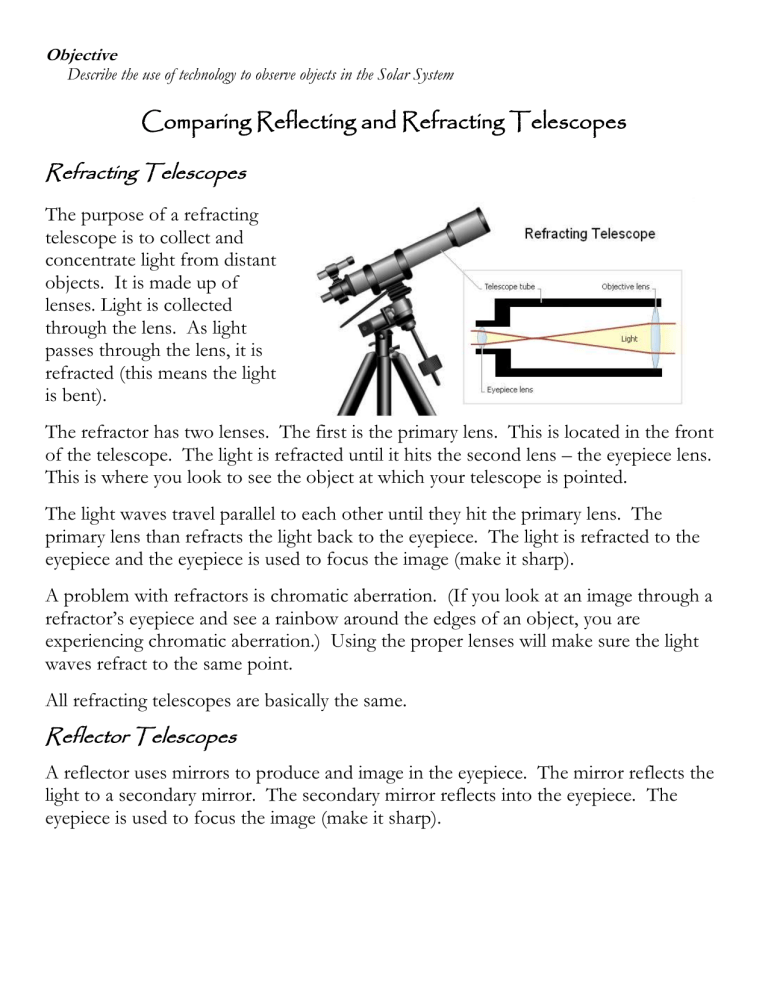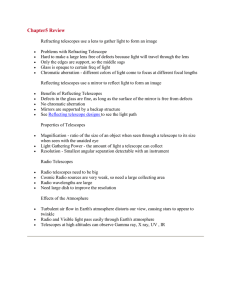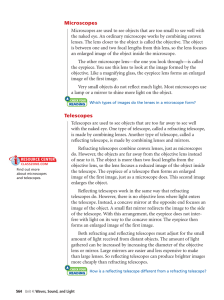Reflecting vs. Refracting Telescopes Worksheet
advertisement

Objective Describe the use of technology to observe objects in the Solar System Comparing Reflecting and Refracting Telescopes Refracting Telescopes The purpose of a refracting telescope is to collect and concentrate light from distant objects. It is made up of lenses. Light is collected through the lens. As light passes through the lens, it is refracted (this means the light is bent). The refractor has two lenses. The first is the primary lens. This is located in the front of the telescope. The light is refracted until it hits the second lens – the eyepiece lens. This is where you look to see the object at which your telescope is pointed. The light waves travel parallel to each other until they hit the primary lens. The primary lens than refracts the light back to the eyepiece. The light is refracted to the eyepiece and the eyepiece is used to focus the image (make it sharp). A problem with refractors is chromatic aberration. (If you look at an image through a refractor’s eyepiece and see a rainbow around the edges of an object, you are experiencing chromatic aberration.) Using the proper lenses will make sure the light waves refract to the same point. All refracting telescopes are basically the same. Reflector Telescopes A reflector uses mirrors to produce and image in the eyepiece. The mirror reflects the light to a secondary mirror. The secondary mirror reflects into the eyepiece. The eyepiece is used to focus the image (make it sharp). Objective Describe the use of technology to observe objects in the Solar System Sir Isaac Newton made the first reflector. It is traditionally called the Newtonian Reflector. The primary mirror collects and concentrates light from distant objects. The parallel light waves reflect off the mirror to the secondary mirror. The secondary mirror reflects the light into the lens of the eyepiece. The light is refracted through the lens in the eyepiece where you look to see the image. Because the reflector uses mirrors, you don’t have a problem with chromatic aberration like the one you do with refractors. Images are sharp and clear. There are many different types of reflecting telescopes. The key difference between the different designs is the location of the secondary mirror. Cassegrain Reflector Schmidt-Cassegrain Reflector With this information, complete the graphic organizer. Objective Describe the use of technology to observe objects in the Solar System Name _____________________________________________________________ Comparing Reflecting and Refracting Telescopes Read the information about reflecting and refracting telescopes and complete the graphic organizer. Reflecting Telescopes Refracting Telescopes Uses lenses or mirrors? Uses lenses or mirrors? What part of telescope collects light? What part of telescope collects light? How is image formed? How is image formed? Does chromatic aberration occur (yes or no)? Does chromatic aberration occur (yes or no)? Types? Types? Objective Describe the use of technology to observe objects in the Solar System Comparing Reflecting and Refracting Telescopes - Key Refracting Telescopes Reflecting Telescopes Uses lenses or mirrors? Uses lenses or mirrors? Mirrors Lenses What part of telescope collects light? What part of telescope collects light? The mirror The lenses How is image formed? How is image formed? Example: Light hits mirror, bounces to secondary mirror, eyepiece focuses image. Example: Light is bent (refracted) as it goes through lens. Eyepiece focuses image. Does chromatic aberration occur (yes or no)? Does chromatic aberration occur (yes or no)? No Yes Types? Types? Example: There are many Example: All refracting different types of reflecting telescopes are basically the telescopes. The key difference same. between the different designs is the location of the secondary mirror.


